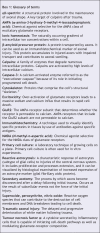Traumatic brain injury: can the consequences be stopped?
- PMID: 18427091
- PMCID: PMC2292762
- DOI: 10.1503/cmaj.080282
Traumatic brain injury: can the consequences be stopped?
Abstract
Traumatic brain injury is a leading cause of morbidity and death in both industrialized and developing countries. To date, there is no targeted pharmacological treatment that effectively limits the progression of secondary injury. The delayed progression of deterioration of grey and white matter gives hope that a meaningful intervention can be applied in a realistic timeframe following initial trauma. In this review we discuss new insights into the subcellular mechanisms of secondary injury that have highlighted numerous potential targets for intervention.
Figures




References
-
- Adekoya N, Thurman DJ, White DD, et al. Surveillance for traumatic brain injury deaths — United States, 1989–1998. MMWR Surveill Summ 2002;51:1-14. - PubMed
-
- Guerrero JL, Thurman DJ, Sniezek JE. Emergency department visits associated with traumatic brain injury: United States, 1995-1996. Brain Inj 2000;14:181-6. - PubMed
-
- Thurman DJ, Alverson C, Dunn KA, et al. Traumatic brain injury in the United States: a public health perspective. J Head Trauma Rehabil 1999;14:602-15. - PubMed
-
- Sosin DM, Sniezek JE, Thurman DJ. Incidence of mild and moderate brain injury in the United States, 1991. Brain Inj 1996;10:47-54. - PubMed
-
- Marshall LF. Epidemiology and cost of central nervous system injury. Clin Neurosurg 2000;46:105-12. - PubMed
Publication types
MeSH terms
Substances
LinkOut - more resources
Full Text Sources
Other Literature Sources
